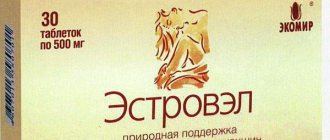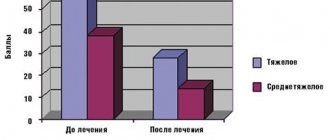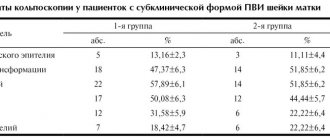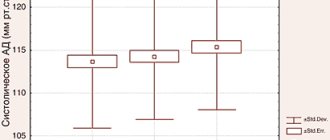Experience of using indole-3-carbinol in the treatment of benign mammary dysplasia
Benign mammary dysplasia is the most common disease among the female population. This pathology affects 30–67% of women of reproductive age, and in women with gynecological diseases, dyshormonal dysplasia occurs in 78–95% of cases [1, 2].
Considering the general pathogenetic basis for the development of benign and malignant diseases of the mammary gland, much attention is paid to the treatment of benign dysplasia as a precancerous disease. The likelihood of malignancy largely depends on the degree of proliferation of breast cells. Thus, with a non-proliferative form of the disease, malignancy occurs in 0.87% of cases, with dysplasia with moderate proliferation - in 2.34%, with severe proliferation - in 31.4% [3].
The main factor that enhances the proliferative activity of mammary gland cells is considered to be an increase in the level of estrogen both in the blood and in the mammary gland tissue itself. Estradiol stimulates differentiation, proliferation and development of the mammary gland ductal epithelium and inhibits apoptosis. In addition, the presence of hormonal imbalance, which manifests itself in the form of relative hypoprogesteronemia, enhances the proliferative effect of estrogens on tissue [2, 4].
Estrogens actively bind to receptors on the membranes of the arcuate nucleus, which causes a decrease in dopamine levels, leading to hyperprolactinemia. In addition, direct stimulation of prolactin secretion by estrogens was detected, activating the expression of the gene responsible for prolactin synthesis. An increase in the level of prolactin entails an increase in the number of estrogen and progesterone receptors, which increases the prolactin-binding ability of alveolar cells of the mammary gland and promotes their proliferation [5].
Estrogen, once inside the cell, activates the estrogen receptor, which facilitates its penetration into the nucleus. Once in the nucleus, this complex stimulates the expression of estrogen-dependent genes. These include vascular endothelial growth factor (VEGF), cyclin-dependent kinase (CDK), insulin-like growth factor (IGF) and other proteins that increase the sensitivity of breast cells to proliferation [5, 6].
Vascular endothelial growth factor stimulates tumor angiogenesis and is a survival factor for immature tumor vessels. In breast cancer, VEGF overexpression is observed in 58% of cases [7, 8].
Estrogens circulating in the bloodstream inevitably pass through the liver, where they are metabolized with the participation of cytochrome P450. Three isoforms of cytochrome P450 are predominantly involved in the metabolism of estrogens - CYP 1A2, CYP 1B1, CYP3A4. The first catalyzes the addition of hydroxyl to the 2-carbon position in the estradiol molecule (E1) and forms a 2-hydroxy derivative (2-OHE1), the second isoform - to position 4 and 4-hydroxy derivative (4-OHE1) and the third isoform to position 16 with the formation of 16- alpha-hydroxy derivative (16-alpha-ONE1). It has been shown that estrone and estradiol represent only 10–15% of the total amount of estrogen derivatives, and 85–90% are estrogen metabolites (mainly hydroxy derivatives) [7]. In addition, estrogen metabolites have greater proliferative activity than estrogen itself. 2-hydroxyestrogens are synthesized with the participation of the enzyme CYP1A1 in the liver and other tissues; they are found in the greatest quantities in breast tissue. These metabolites have a weak estrogenic effect (48% of estradiol activity) and precisely because of this they do not have a proliferative effect on cells. 16-hydroxyestrogens - with the participation of cytochrome 3A4, 16-alpha-ONE1 is formed. The mitogenicity of this metabolite is 8 times higher than that of estradiol, since 16-alpha-ONE1 can covalently and irreversibly bind to endoplasmic reticulum loci, along with binding to nuclear estrogen receptors, which provides stimulation over days rather than hours, while the effect is maintained until the binding proteins are degraded. 4-hydroxyestrone (4-OHE), another estrogen metabolite, like 16-alpha-ONE1, has estrogenic activity (79% of the activity of estradiol). The carcinogenic mutagenic effect of 4-hydroxyestrone can be explained by the influence of its toxic quinol metabolites, the induction of the formation of free superoxide radicals and damage to cell DNA. Thus, an increase in the production of these metabolites is considered as evidence of qualitative changes in steroidogenesis and a factor in the development of some malignant neoplasms [17].
The search for drugs for the treatment of benign mammary dysplasia has led to the development of agents containing indole-3-carbinol, which reduce the proliferative activity of estrogen-dependent cells and have antitumor activity.
Characteristics of indole-3-carbinol-containing dietary supplements
In the treatment of benign mammary dysplasia, we used three biologically active food supplements containing indole-3-carbinol: Stella, Indinol and Estrovel (Table 1).
Stella is available in the form of three-color capsules of 400 mg. The yellow capsule contains 100 mg of indole-3-carbinol, found in cruciferous vegetables. Indole-3-carbinol has the following effects:
1) stimulates the 2-hydroxy estrogen detoxification pathway; 2) modulates estrogen receptors (estrogen receptor alpha antagonist); 3) stimulates apoptosis of cancer cells; 4) inhibits tumor angiogenesis; 5) antioxidant.
The green capsule contains 60 mg of epigallocatechin-3-gallate, found in green tea. Epigallocatechin-3-gallate has the following effects:
1) reduces the production of the aromatase enzyme, which promotes the conversion of androgens into estrogens; 2) selectively reduces the rate of vascular growth in neoplasms, that is, it suppresses the production of vascular endothelial growth factor (VEGF).
The red capsule contains 60 mg of soy isoflavones (genistein and dzadzein), which have the following effects:
1) stimulate 2-hydroxylation of estrogens; 2) competitively bind to estrogen receptors; 3) reduce the secretion of 4-hydroxy estrogens; 4) increase the production of sex-binding globulin.
It is recommended to take Stella to normalize estrogen metabolism (restoring the normal ratio of 2-hydroxyestrogen and 16-alpha-hydroxyestrogen and reducing the production of 4-hydroxyestrogens), to improve the functional state of the female reproductive system and reduce the risk of hormone-dependent diseases of the female reproductive system, such as fibroids, mastopathy , endometriosis and as part of complex therapy of the latter. Recommended doses: 1 yellow capsule in the morning, 1 green capsule in the afternoon and 1 red capsule in the evening - for 1 month. If necessary, treatment can be extended to 3–6 months, 1–2 times a year at regular intervals [18].
Indinol is available in 300 mg capsules. Each capsule contains 90 mg of indole-3-carbinol and excipients, including magnesium stearate 3 mg.
Indinol should be taken for prevention and as part of complex treatment of benign diseases of the mammary glands. It is also recommended to take Indinol when benign mammary dysplasia is combined with other diseases of the female reproductive system: endometriosis, uterine fibroids, endometrial hyperplasia, cervical dysplasia, genital condylomatosis.
Estrovel is available in 500 mg tablets. It contains indole-3-carbinol (25 mg per tablet), cohosh racemosa extract (30 mg per tablet), wild yam root extract (50 mg), soy isoflavones (25 mg), vitamins B6, E, folic acid and other auxiliary components in small quantities.
Cosimifuga racemosa and wild yam root have been used since ancient times to treat menopausal disorders in women. Soy isoflavones are phytoestrogens and compensate for the negative effects of estrogen when it is in excess. Therefore, in addition to the therapeutic effect on breast tissue, Estrovel helps to normalize unstable blood pressure, reduces the intensity of headache attacks, and reduces the frequency of hot flashes in women with neurovegetative disorders during menopause. The recommended dose of Estrovel is 1-2 tablets per day for 2 months.
In many Russian cities there are no large mammology centers. Identification, clinical observation and treatment of patients with dishormonal dysplasia of the mammary gland is carried out by local obstetricians-gynecologists. In turn, an analysis of outpatient records of a dispensary group of patients showed that treatment of diseases of the mammary glands is not always carried out adequately to their objective condition, changes in ultrasound and mammography, and the presence of concomitant gynecological pathology. Therefore, research into the use of indole-3-carbinol-containing dietary supplements will help more rational treatment of women with diseases of the mammary glands.
Purpose of the study: to analyze the effectiveness of treatment of women of different age groups with dyshormonal dysplasia of the mammary glands with indole-3-carbinol-containing dietary supplements.
Patients and methods. A total of 192 women registered with a mammologist with a diagnosis of benign dishormonal dysplasia of the mammary glands were treated with indole-3-carbinol-containing dietary supplements (as part of complex therapy). The age of the patients ranged from 17 to 56 years. The duration of observation by a mammologist ranged from 1 to 19 years. All patients underwent ultrasound examination of the mammary glands. Women 40 years and older - ultrasound examination and mammography.
Group 1 included 52 women aged 17 to 35 years. The group accepted Stella for 3 months.
Group 2 consisted of 103 patients aged 17 to 50 years who received Indinol. There were 48 patients of reproductive age, 55 patients of premenopausal and menopausal age.
Group 3 included 37 women aged 50 to 56 years who were treated with Estrovel.
Evaluation of the results of therapy included an analysis of the intensity of pain in the mammary glands, the state of the structure of the breast tissue during examination and palpation, and changes in the breast tissue during an ultrasound examination.
Pain intensity was assessed using a verbal scale ranging from 0 to 4:
- 0 points - no pain;
- 1 point – mild pain;
- 2 points - moderate pain;
- 3 points - severe pain;
- 4 points - unbearable pain.
The condition of the breast tissue was assessed based on examination and palpation in scores from 0 to 6 [11]:
- 0 points – absence of pathological process;
- 1 point - mild diffuse fibroadenomatosis;
- 2 points - moderately severe diffuse fibroadenomatosis;
- 3 points—severe diffuse cystic or fibrous fibroadenomatosis;
- 4 points - pronounced diffuse cystic or fibrous fibroadenomatosis;
- 5 points - localized fibroadenomatosis against a diffuse background;
- 6 points - localized fibroadenomatosis against a background of diffuse fibroadenomatosis.
The results obtained and their discussion
Group 1 included women of reproductive age. All patients complained of severe pain in the mammary glands before menstruation for 7–10 days (78%) or moderate pain not associated with the cycle (22%). During examination, lump-like compactions in the mammary glands were more common - 5 points (63%) and medium-grained compactions - 4 points (37%). In 80% of cases, upon examination, the breast tissue is dense and swollen. During an ultrasound examination, the picture in all women corresponded to a mixed (fibrocystic) form of mastopathy. The maximum size of cysts is 14.5 mm.
Women of the 1st group were prescribed Stella capsules, 1 pc. 3 times a day for 1 month (according to the instructions and voluntary certification, translated into indole-3-carbinol 100 mg). This treatment was carried out as part of complex therapy, which included vitamins and microelements. For severe pain, Mastofit Evalar cream was used topically 2 times a day, 7–10 days a month.
All women tolerated the treatment well. Many noted the modern color design of the tablets, which increased the motivation of patients for consistent treatment. Improvement occurred in 72% of women. Pain in the mammary glands, both premenstrual and not associated with the cycle, decreased to mild, although the pain syndrome was not completely relieved. 26% of patients did not note any significant improvement in their condition. And 1 patient (2%) after treatment complained of increased pain in the mammary glands before menstruation.
Upon examination, an improvement in the condition of the mammary glands was noted in 86% of women. The breast tissue has become softer and more uniform (3–4 points). Lump-like seals persisted in 27% of patients. During control ultrasound, no significant changes were noted: tissue fibrosis remained, the size of the cysts did not decrease. Patients are recommended to continue the course for up to 3–6 months.
All women of group 2 complained of pain in the mammary glands. Women of reproductive age were bothered by pain before menstruation 10–14 days in advance. The patient's pain intensity was characterized as moderate (40%) and severe (60%). On examination, the structure of the mammary glands is dense-grained, heterogeneous, which corresponded to 3–4 points (56%) and 5 points (44%). On ultrasound, women of reproductive age have fibrous changes and cysts from 0.7 to 1.2 cm. In women of pre- and menopausal age, ultrasound and mammography examinations revealed a fibrocystic or fibrous form of mastopathy with symptoms of fatty involution.
When prescribing Indinol, adjustments were made to the dose and duration of treatment. In the instructions included with the package, the recommended dose is 1 capsule per day for 2-3 weeks. But in the literature devoted to the treatment of breast diseases, the doses used range from 2 to 4 capsules per day with a duration of administration from 1 to 6 months [9, 12–14]. There is evidence of the dependence of the doses used on the patient’s weight. Thus, women up to 60 kg need to take 1 capsule 3 times a day, and women over 60 kg need 2 capsules 2 times a day [14]. But such an increase in the dose and duration of administration requires additional financial costs, which limits the range of patients to whom treatment can be prescribed.
We decided to go with an average dose - 300 mg (1 capsule) 2 times a day (translated into indole-3-carbinol 180 mg). In case of severe pain, Mastofit Evalar cream was additionally prescribed topically to the mammary glands 2 times a day 7–10 days before menstruation.
All patients completed a three-month course of treatment. No allergic reactions or adverse symptoms were observed. In 61% of women of reproductive age, premenstrual pain syndrome significantly decreased to mild pain 3-5 days before menstruation. 52% of women of pre- and menopausal age noted both a decrease or disappearance of pain and a decrease in sensations in the mammary glands such as burning, tingling, and itching.
When examining the mammary glands, a softer and more homogeneous tissue structure (2–3 points) was noted in 83% of women of reproductive age and 64% of women of pre- and menopausal age. The control ultrasound did not reveal any visible positive changes in women of either age group: cysts of the same size, fibrosis in the same volume.
According to the literature, the maximum effect in the treatment of patients is observed by the 6th month. The disappearance of mastalgia and mastodynia is observed in 70.4–90.5% of patients [12–14]. Moreover, 100% effectiveness of treatment was noted in patients with glandular mastopathy [15]. An improvement in the mammographic picture in 33.7% of patients is observed by the 12th month after treatment [16]. Therefore, women in this group were recommended to continue treatment with Indinol.
Women of the 3rd group complained of severe (35%) and moderate (65%) pain in the mammary glands and symptoms characteristic of menopausal syndrome: hot flashes, fever, palpitations, sweating. Patients were prescribed Estrovel 1 tablet 2 times a day for 3 months (according to the instructions and voluntary certification, translated into indole-3-carbinol 50 mg). For severe pain in the mammary glands, Mastofit Evalar cream was used topically 2 times a day 7–10 days before menstruation.
Upon examination, the mammary glands had a fine- or medium-grained structure and a dense consistency (2–3 points). Ultrasound reveals fibrous changes in breast tissue against the background of involution. Mammograms showed a similar picture.
The available literature on the use of Estrovel in women during perimenopause shows good tolerability and 100% effectiveness against neurovegetative symptoms [17].
During the treatment of our 37 women, one patient experienced an exacerbation of chronic cholecystopancreatitis. Estrovel had to be cancelled. The remaining 36 women tolerated the treatment well. After three months of therapy, 68% of patients noted an improvement in their health: pain and discomfort in the mammary glands decreased. Severe pain bothered only 8% of patients. Neurovegetative symptoms became less pronounced in 68% of women, and 32% noted the disappearance of hot flashes and fever. Upon examination, the mammary glands became softer and more uniform (1–2 points) in 62% of women (Table 2). But the control ultrasound did not reveal any obvious positive dynamics.
conclusions
- Indole-3-carbinol-containing dietary supplements are highly effective in the complex treatment of patients with benign dishormonal dysplasia of the mammary glands.
- Treatment with indole-3-carbinol-containing dietary supplements is well tolerated by women of reproductive, premenopausal and menopausal age.
- An improvement in the subjective state in the form of a decrease in the intensity and duration of pain in the mammary glands was noted in 61–78% of women of reproductive age and 52–68% of women of pre- and menopausal age. Improvement in objective indicators in the form of improvement in the structure of breast tissue was noted in 83–86% of women of reproductive age and 62–64% of women of pre- and menopausal age.
- To achieve maximum effectiveness from therapy and positive dynamics of the objective condition of the mammary gland according to ultrasound and mammography, it is necessary to continue treatment (as part of complex therapy) with indole-3-carbinol-containing dietary supplements for up to 6 months.
Literature
- Letyagin V.P., Vysotskaya I.V., Kim E.A. Pogodina E.M., Maksimov K.V. Herbal medicine for diffuse fibrocystic disease. M.: ABV-press, 2008. 28 p.
- Mustafin Ch. K., Kuznetsova S. V. Dyshormonal diseases of the mammary gland. Clinical manual / Ed. Pinkhosevich E. G. M., 2009. 126 p.
- Vasilevsky A.V., Kozlovskaya N.A., Ilkevich A.G. et al. Benign and malignant diseases of the breast: A manual for students and doctors. Ed. L. A. Putyrsky, Yu. L. Putyrsky. M.: LLC "Med. information agency", 2008. 336 p.
- Chistyakov S. S., Selchuk V. Yu., Grebennikova O. P. et al. Cancer and benign tumors of the breast: A textbook for the system of postgraduate professional education. Ed. S. S. Chistyakova. M.: Author's Academy, 2009. 120 p.
- Gilyazutdinov I. A., Khaskhanov R. Sh. Benign tumors of the mammary glands: A guide for doctors. Kazan: Medical literature, 2007. 216 p.
- Vysotskaya I.V. Modern possibilities for the treatment of fibrocystic disease // Tumors of the female reproductive system. 2009. No. 1–2. pp. 44–46.
- Vozny E.K., Belonogov A.V., Satirov E.F., Yurgina O.V. Breast cancer (modern approaches). Clinical mammology. Thematic collection. 1st edition. M.: LLC Firma Strom", 2005. 181–189.
- Speirs V., Atkin SL Production of VGEF and expression of the VEGF receptors Ade-1 and KDR in primary cultures of epithlial and stromal cells derived from breast tumors // Br J Cancer. 1999. No. 80 (5–6). 898–903.
- Kiselev I.V., Lyashenko A.A. Indinol is a regulator of proliferative processes in the organs of the reproductive system. M.: ZAO MiraxPharma, 2008. 48 p.
- Sidorenko L. N. Mammary gland. How to protect yourself from cancer. A book for every woman. SPb: Folio-Press. 1998. 704 p.
- Rakhimzhanova R.I., Suleimenova E.V., Mayer K.M., Solomonova A.M. Experience of using indinol in the treatment of various forms of mastopathy in Kazakhstan. Organizational, medical and technical aspects of clinical mammology. Mater. 5 All-Russian scientific-practical conf. with international participation. M., 2007. 130–132.
- Rozhkova N.I., Meskikh E.V. Evaluation of the effectiveness of the drug indinol in the treatment of various forms of mastopathy. Organizational, medical and technical aspects of clinical mammology. Mater. 5 All-Russian scientific-practical conf. with international participation. M., 2007. 149–152.
- Rozhkova N. I., Burdina L. M., Smetnik V. P. et al. Complex allopathic and homeopathic treatment of mastopathy // Bulletin of the Russian Association of Radiologists. 2009. No. 1. 148–152.
- Zulkarnaeva E. T., Khakimova R. Kh., Lapan E. I., Blagodetev I. L. Indinol-3-carbinol in the treatment of benign breast diseases // Tumors of the female reproductive system. 2008. No. 3. P. 50–54.
- Kulagina N.V. Therapy of fibrocystic disease of the mammary glands in patients with uterine fibroids // Tumors of the female reproductive system. 2010. No. 1. P. 40–43.
- Kulchavenya E.V., Brizhatyuk E.V., Breusov A.A. The effectiveness of the dietary supplement estrovel in the complex therapy of women with chronic cystitis during perimenopause // Obstetrics and Gynecology. 2009. No. 3. P. 69–71.
- Bradlow HL, Telang NT, Sepkowic DW et al. // J Endocrinol. 1996; 150: 259–265.
- Information letter from ROAG. M., 2009.
E. A. Sukhareva*, Candidate of Medical Sciences L. A. Ponomareva**, Doctor of Medical Sciences, Professor S. V. Kozlov**, Doctor of Medical Sciences, Professor
*MUZ City Clinic No. 1, Syzran ** State Budgetary Educational Institution of Higher Professional Education SSMU named after. V. I. Razumovsky Ministry of Health and Social Development of Russia, Samara
Contact information for authors for correspondence
Doctors' recommendations
Regardless of the method of treatment and the severity of the disease, it is recommended to follow a number of rules:
- reduce, or better yet eliminate, the consumption of coffee, strong tea and cocoa;
- get rid of addictions to alcohol and smoking;
- follow the rules of healthy lifestyle;
- add fish, boiled or baked lean meat, vegetables, fruits and cereals to the menu;
- wear underwear of your size and appropriate shape;
- Avoid exposure to sunlight and heat (baths, solariums).
As a result of incorrect, untimely treatment or lack thereof, a complication in the form of oncology is possible. For this reason, it is important to perform breast self-exams, visit your doctor regularly, and follow his or her prescriptions. The earlier the disease is diagnosed, the easier it will be to get rid of it without serious consequences.






